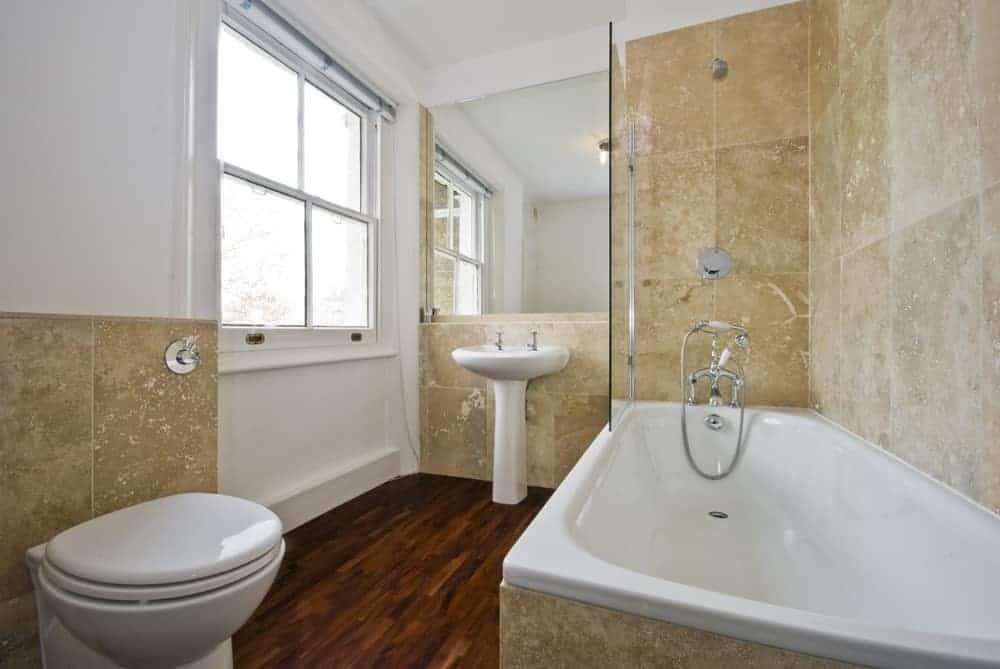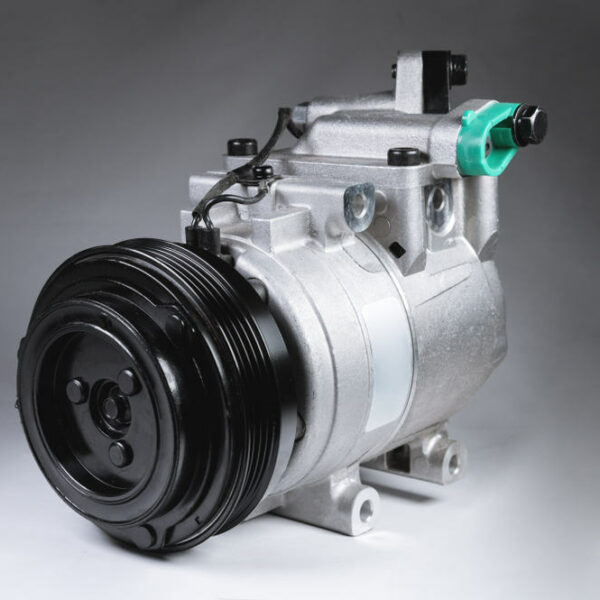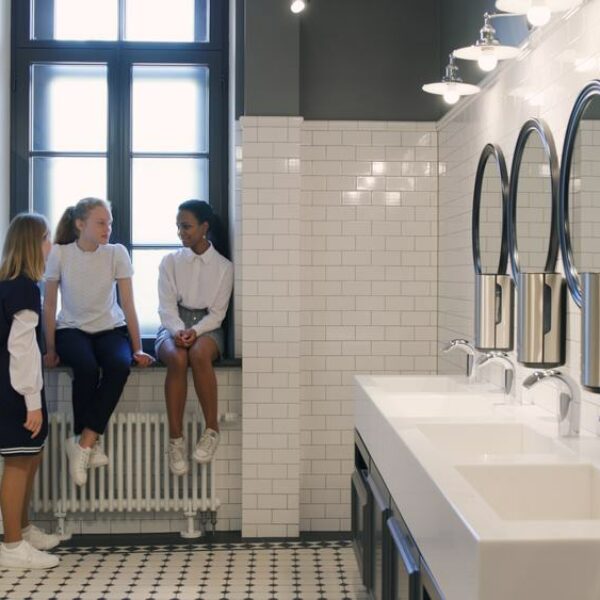Laminate flooring is one of the most popular options out there. Its clean lines and attractive wood or stone patterns look great in any room.
But when it comes to using it in the bathroom, you might have some questions. Will it cope with the wet and humid conditions? How long can you expect it to last? In short – is it a good choice?
That’s what we’re here to find out! We’re going to look at the pros and cons of using laminate flooring in a bathroom. And we’ll tell you everything you need to know to make an informed choice.
So if you’re ready, let’s get started!
can you put laminate in a bathroom?
What is laminate flooring?

Let’s start by taking a closer look at how laminate flooring is constructed.
The product was first produced back in the 1970s in Sweden and marketed under the name Pergo. Pergo is still going strong today, and some people even use the brand as an alternative name for laminate.
It’s made of a wood chip base, with a layer of paper impregnated with resin on top. This paper is printed with the design of either wood of stone, giving multiple different looks. On top of the paper there’s a clear layer, to help it resist wear and tear.
Some laminate flooring is designed to be glued into place. Other types have edges shaped so that they lock together.
Installation
Laminate flooring is easy to install, although it does have some requirements.
It’s a good idea to use it with underlay. That will help control moisture levels and give the laminate a soft surface against which it can expand and contract.
Once the underlay is in place, most laminate can simply be clicked and locked into position. Some products have self-adhesive backs instead, which allow you to press them into place. Self-adhesive laminate flooring is, however, usually thinner than the click-and-lock variety.
Whichever option you choose, it’s very easy to do. So if you’re looking for a bathroom flooring option you can install yourself, laminate could be it. And you won’t need to be a DIY expert to get good results.
Just remember to leave an expansion gap around the outside of the flooring. This needs to be between 10 and 12 millimeters. It will give your floor space to flex as the temperature changes. You can cover up the gap with a baseboard or trim.
Maintenance
Laminate is one of the least labor-intensive types of flooring out there when it comes to maintenance. All that’s required to remove dust and debris is a regular brush or vacuum. Do it every day if you can – those dust particles can have hard edges that can otherwise abrade the floor.
If you’re using a brush, make it one with soft bristles to avoid scratching the surface. And if you’re using a vacuum cleaner, you’ll want one with a setting for hard floors.
When your floor needs an extra clean, a damp mop will do the trick. Notice that we say damp, not wet. Excessive moisture can cause your laminate to swell and distort. And the planks may raise up at the edges. So use a spray-on laminate cleaner, and wring out the mop thoroughly before you get to work.
As with the brush, you’ll want a mop that’s nice and soft. One made with microfiber is ideal. But steer clear of steam mops. The steam can penetrate the surface of the laminate and cause the same problems as excessive water.
Don’t be tempted to use any waxes or polishes either. They’ll simply build up on the flooring and cause the surface to dull. They can also leave you with a very slippery floor – a recipe for disaster in a bathroom.
One thing to be aware of is that, unlike wooden flooring, laminate can’t be refinished. If the wear layer or print is damaged, sanding will only make it worse. Your only option at that stage will be to rip the flooring out and replace it.
The good news is that bathrooms are likely to have less heavy wear than other rooms in the house. Laminate with a decent wear layer should be more than able to stand up to the traffic there. Most brands come with a warranty of at least 10 years.
Is it waterproof?

All those references to avoiding excessive moisture might be making you worried. After all, we’re talking about using this flooring in a bathroom – and bathrooms get wet. So can laminate flooring cope?
Well, it isn’t completely waterproof in the way that, say, rubber or sheet vinyl is. That’s because no matter how small they are, the gaps between the planks can admit water.
The odd splash won’t be a problem. Just wipe it up promptly, and it won’t have time to penetrate the core. In fact, laminate flooring is more water resistant than hardwood.
But you will need to be Johnny-on-the-spot when it comes to those spills. If you leave standing water for too long, you will be looking at problems. And once the flooring is damaged, the only option is to replace it.
Overall, then, laminate flooring will be fine for most bathrooms. But if you’re likely to get a lot of splashing – if you have toddlers who love bath time, for example! – there are better choices.
Appearance
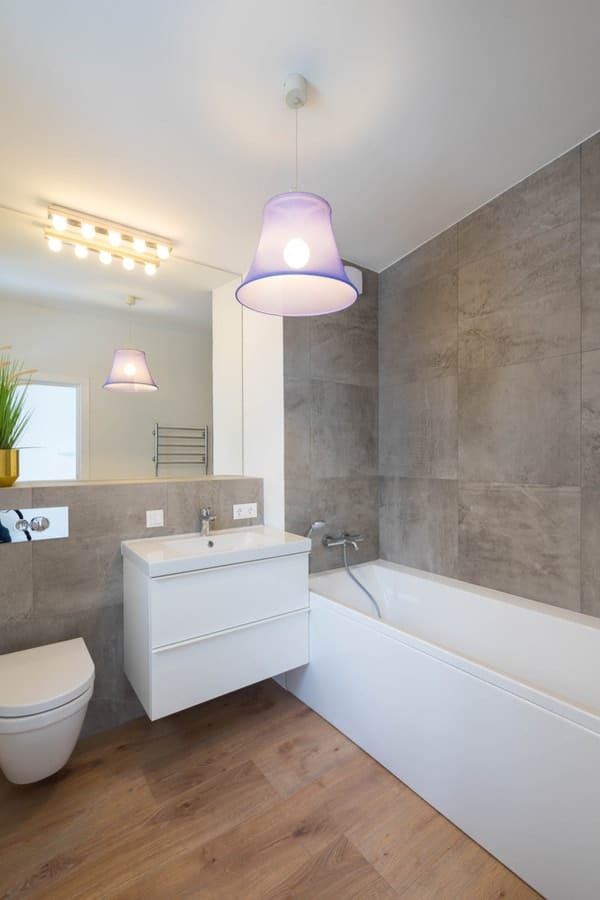
Most laminate today uses high definition printing to reproduce the look of wood or stone very accurately.
If you choose a wood finish, an even more realistic option is to pick laminate that is “embossed in register”. This process, often shortened to EIR, refers to the texture embossed on the surface of each plank. With EIR, this embossing matches the printed woodgrain.
The result is a plank that looks and feels very like real wood. And remember that real wood will need to be sealed and varnished if it’s going to be used in a bathroom. That means that in practice, the two textures are difficult to tell apart.
With stone finishes, on the other hand, anyone stepping onto the flooring will know it’s not the real thing. Laminate doesn’t feel like stone underfoot, and it doesn’t sound like stone either.
That isn’t always a bad thing, however. If you’ve ever walked on a stone floor when the temperature is low, you’ll know it can be very uncomfortable. So if you like the look, but don’t have underfloor heating, laminate is a great option. Your toes will thank you for it when the mercury falls!
Price

As with any other type of flooring, the price you’ll pay for laminate can vary significantly. Generally speaking, thicker boards with more durable wear layers will be more expensive.
Nevertheless, it still compares favorably to other kinds of flooring. If you want the look of a wooden or stone floor, laminate is a much less expensive way to achieve it.
And because it’s so easy to install, you won’t need to hire a professional to do the job for you. Compare that to a stone floor, which requires specialist expertise and equipment, and the savings are clear.
Environmental sustainability
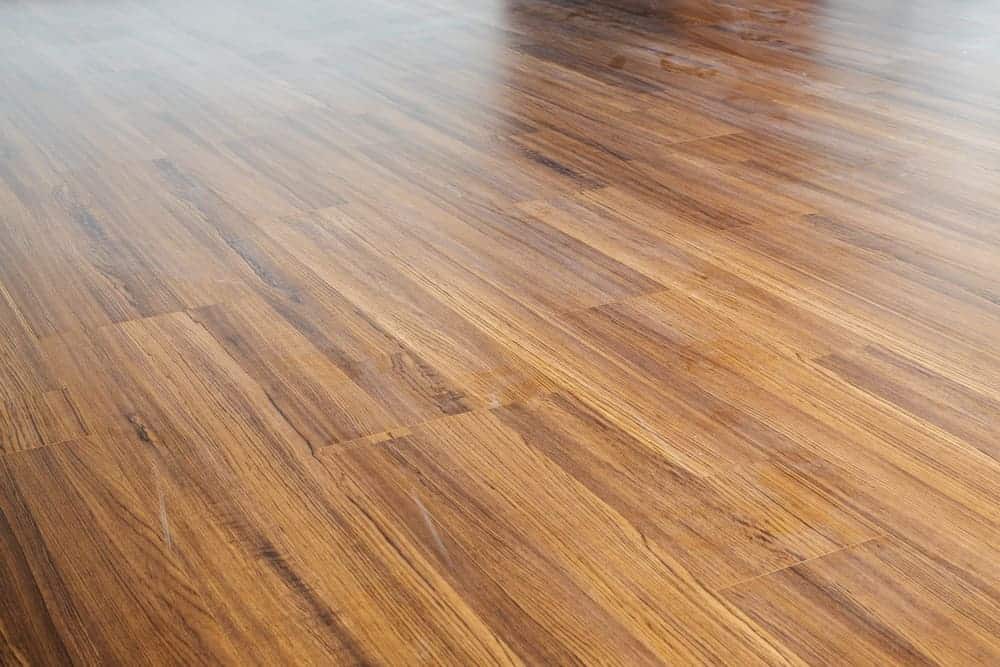
When it comes to the environment, laminate flooring isn’t always the most sustainable option. That’s because the wood fibers are bonded with melamine resin – and that includes formaldehyde.
The levels of formaldehyde in modern laminate are, however, lower than in the past. You can also look out for laminate flooring with low formaldehyde content. It will be marked with the designation CARB, P2, E1 or E0.
Another important component to consider in relation to sustainability is the wood fiber used in construction.
Look for products that have taken their wood from sustainably managed forests. The FSC (the Forestry Stewardship Council) and the PEFC (the Programme for the Endorsement of Forest Certification) provide independent accreditation.
Look for their logos on the packaging to be confident you’re making a sustainable choice.
The good news about all laminate flooring is that it is completely recyclable. So when it’s time for a change, take it to your nearest recycling center. You’ll be giving it a new lease of life, and avoiding it going needlessly to landfill.
So to sum up …
Laminate flooring has plenty of pros when used in bathrooms. It’s inexpensive, with a wide range of options in terms of color and finish. It’s easy to install. It requires minimal maintenance. And with reasonable care, it will last for years.
But it’s not 100 per cent waterproof, so you will need to wipe up splashes promptly. If you choose a stone finish, the texture won’t fool anyone. And you do need to choose your product carefully to make sure you’re getting an environmentally sustainable option.
Ready to choose your new bathroom floor?
We hope you’ve enjoyed our round-up of the pros and cons of laminate flooring in a bathroom. And we hope it’s helped you decide whether it’s the right choice for your home.
We think it has plenty to recommend it. Just think twice if your children turn your floor into a swimming pool at bath time! While it will cope with a bit of moisture, lots of standing water will cause damage.
Whether you choose laminate flooring or something else, good luck with your bathroom renovation!
